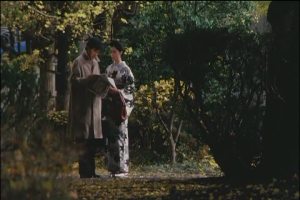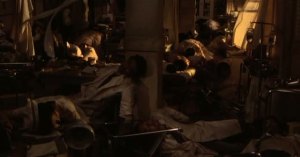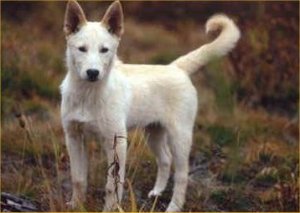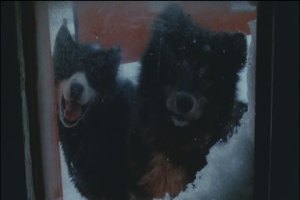Antarctic Echoes
 Antarctic Film Month draws to a close a week later than expected due to a bout of ill-health, with the appropriately named Antarctica, based on a true story and taking us back to the year 1957.
Antarctic Film Month draws to a close a week later than expected due to a bout of ill-health, with the appropriately named Antarctica, based on a true story and taking us back to the year 1957.
Antarctica
(1983) Written by Tatsuo Nogami, Susumu Saji , Toshirô Ishidô, & Koreyoshi Kurahara
Directed by Koreyoshi Kurahara
Showa, established in January 1957 on East Ongul Island, was and continues to be one of Japan’s most active Antarctic stations. After construction was completed, 11 men and 15 sled dogs remained on site and Showa began its long life as a polar scientific outpost. In February of the following year, the team left the base having completed their tenure, and the dogs were left behind with a small supply of food to keep them nourished until the relief crew arrived shortly afterward to take over their care. However, adverse weather conditions prevented the intended 2nd expedition team from making landfall, and the animals had to be abandoned. It would be a full year before another expedition team returned to Showa. Joining them was Professor Yasukazu Kitamura, responsible for the dogs in 1958 and whom had never forgiven himself for his decision to chain them together – a sentiment shared by the Japanese public of the day.

Early expeditions at Showa Station relied heavily on the use of sled dogs, leading to a deep bond between husky and handler.
The team would discover 7 dogs dead on the chain, with 6 having broken free and missing. Miraculously, brothers Taro and Jiro, who had been born and raised in Antarctica, had managed to survive. Kitamura suggested that they had subsisted on a diet of penguins, trapped fish, seal faeces, and seabirds. The dogs became national heroes and interest in the Sakhalin breed saw a major resurgence in Japan both in 1959 and again in 1983 with the release of Antarctica. Koreyoshi Kurahara’s epic dramatisation of these events combines both fact and fiction as it retells what is known as well as attempting to speculate on the fate of the huskies.
________________________________________________________________________________________________________
Connections
Showa Station also appears in Virus, aka Day Of Resurrection, where scientist Yoshizumi and his colleagues first learn of the infection’s decimation of Japan and beyond. The feature was reviewed recently as part of Antarctic Film Month.
_________________________________________________________________________________________________________
In the wrong pair of hands, it could easily be a cornball fest for animal lovers, but in practice, Antarctica manages to strike an acceptable balance between sentiment and historical drama, one in which the canine performers could be said to have equal screen presence with their human counterparts. To an extent, any film that makes use of Antarctica in its storytelling cannot help but be dramatic. The severe, jagged white landscape of the continent is the very essence of spectacle, and, as demonstrated in The Thing – even though the sci-fi/horror was filmed entirely in North America – a place of great hazard.
“In the wrong pair of hands, it could easily be a cornball fest for animal lovers, but in practice, Antarctica manages to strike an acceptable balance between sentiment and historical drama.”

Forced to abandon the dogs to their fate, the expedition returns to a hostile reception, especially by the Japanese press.
All of this is encapsulated at the very beginning of Antarctica, from the montage of polar scenery accompanied by Vangelis’s dated but still powerful electronic score to the near-fatal expedition by Ushioda, Ochi and Ozaka, along with 15 sled dogs to remote inland post Botsnnuten. This sequence alone conveys the deep bond and interdependence between the dogs and their human masters, particularly the first two members of the team, responsible for the dogs’ wellbeing. Ushioda is the alter ego of Professor Kitamura in the film, and actor Ken Takakura expertly brings to life his Atlas-like sense of responsibility and later anguish at having chosen to chain the dogs together in the expectation that the 2nd expedition will ensure their care. With the expedition pilloried in the Japanese press for abandoning the dogs to their fate, both director Kurahara actors Takakura and Tsunehiko Watase as Ochi work hard to show that no-one was more haunted by that decision than the men themselves.
The film also suggests the wanderlust of the two dog lovers, the men finding themselves at a loss to reconnect to Japanese society upon their return. It is not only the dogs that they have left behind, but a major part of themselves and a sense of purpose as the pioneers of the new Antarctic base. Colorful and busy Hokkaido has carried on without them, its people only dimly aware of their experiences and unable to understand their feelings of disconnect. Indeed the only citizens who come close are the families who supplied the dogs, and bereft of their loved ones, have only recrimination to offer the polar scientists. The audience too feels a sense of alienation during the scenes in Hokkaido. We have also travelled to Antarctica and can’t quite reconcile the quiet university halls, bright traditional festivals, and rolling green fields of this world. This is made all the more powerful by the continual juxtaposition of these scenes with the ongoing fate of the dogs in the Antarctic: we cannot carry on without them because we alone know they are still there, and their fate has not yet played out.
With the humans gone from Showa, the dogs take centre-stage, and it is down to some serious animal training, special effects, and post-production that the Kurahara is able to sell his drama to the audience. A good measure of how successful this was is the fact that the director was criticised at the time for animal cruelty, gaining a rating of ‘Unacceptable’ by the American Human Association. Kurahara Productions would respond by stating that all death scenes or sequences placing animals in peril were carefully recreated in a studio under controlled conditions. Filming reportedly took place in the snow-covered climes of Northern Hokkaido, interspersed with second unit footage of Antarctica itself.
______________________________________________________________________________________________________________________________________________________________
Connections
The term Sakhalin derives from the Russian island of the same name, where the huskies were originally bred. North of Hokkaido, the long and slender landmass known in Japanese as ‘Karafuto’ has long been a point of contention for the two nations, only in recent history becoming fully Russian territory. Before this, its sovereignty regularly changed and it was once home to the Ainu, an indigenous population since relocated to Japan in the 20th Century. The dogs used in the expedition were bred in Hokkaido. Eight Below, Hollywood’s remake of Antarctica, uses Siberian huskies and Alaskan malamutes – a malamute also having been used in The Thing, reviewed last week.
Pictured left: A Sakhalin husky. Acknowledgements to www.dogfacts.org for the photo.
________________________________________________________________________________________________________________________________________________________________
“The audience too feels a sense of alienation during the scenes in Hokkaido. We have also travelled to Antarctica and can’t quite reconcile the quiet university halls, bright traditional festivals, and rolling green fields of this world.”
However it was done, the attempt at realism paid off, with the plight of the dogs still just as believable today as it appeared in 1983. Sequences that could now only be achieved through CGI are all the more solid and powerful knowing that they were practically realised. Kurahara seems also to be aware that such sequences can only be used sparingly, not only for dramatic reasons, but also because even in a canine-centric tale, human drama will always be more compelling.
This is further evident with the presence of a narrator over the scenes where the huskies are fending for themselves. It gives both the impression at times of a documentary, but also an uninvited dose of silliness, as the narrator attempts to explain what the dogs are feeling and their motivations in a particular scene. The viewer is well-aware of the situation and can easily discern the action from the screen. It would have been far more powerful to let the visuals and the soundtrack to tell the story than a patronising anthropomorphisation of the protagonists. Fortunately, this is not a major irritation and the visuals do indeed speak volumes.
There is a definite underlying theme of Japanese indomitability throughout the tale, perhaps unsurprising given the pioneering subject matter. An amusing scene between the rescued crew and the captain of the U.S icebreaker Burton Island assisting in their departure underscores the strong sense of nationalism that might have been more pervasive had Antarctica told the story of the Showa base itself. While those at home did not fully appreciate the difficulties of the mission, there was a great sense of national pride at the expedition itself. It had not been long since the Second World War and a rapidly rebuilding nation had in only 12 years joined the Antarctic program long dominated in the early 20th Century by public and private enterprise in the U.S. The sentiment of which only occasionally bubbles to the surface in Antarctica, serving as a powerful undercurrent to the story and a context to the ‘can-do’ spirit of the team, as opposed to a time-serving mentality one might be more likely to find in the South Pole today now that the novelty has worn off.
To the average viewer however, Antarctica is the poignant true story of life and death for man’s best friend in one of the harshest places on earth. I won’t claim to have shed tears during its 143 minutes, but having owned a dog or two in my life, I also cannot say I was unaffected by their predicament. There is a certain amount of guilt at confessing to an enjoyment of animal-based drama, largely in part due to Disney’s many years of cheapening the genre. The genuine article is a different beast altogether, and stands on higher ground with its honesty. Realistically-drawn, well-paced and visually-arresting, Antarctica remains an epic retelling of history and a compelling emotional tale for humans and canines alike decades after its original release. For the polar enthusiast, it returns us to the final days of an era when Antarctica was the last great frontier, before it was conquered by the inevitable mediocrity of familiarity and taxation.
*****
Further Reading
To see photos of the actual expedition at Showa Base and the dogs Taro and Jiro, visit this page. Scroll down until you see the photo section.
Click here to read the assessment of the American Human Association on Antarctica.
Visit this page to learn additional information, including the thoughts of Professor Kitamura.
*****
Next Time
Clips, or it didn’t happen: we return to where it all began and look at the ‘A’ series of World On Film – a chance to discover the films reviewed earlier all on one page. With pictures.
Song Of White
Having established our historical credentials last week, the polar journey continues with a dramatic left turn into thriller with the epic international co-production:
Virus, aka Day Of Resurrection
(1980) Co-written & Directed by Kinji Fukasaku
(You’ll find a trailer at the bottom of last week’s post)
“I wanted my name to be entered into the history books, but I wanted it to be for something meaningful, something lasting. What could I have done that would have made the slightest damn bit of difference… wha… what could I have done?”
Germ warfare plagues the earth when a military-created virus is accidentally released into the planet’s atmosphere, killing almost everyone worldwide. The only survivors are a group of scientists in Antarctica, where the virus lays dormant in extreme low temperatures. The international fragments of humanity must put aside their political differences and rebuild society; however the apocalypse may not yet be over.
Coming in at just over 156 minutes, Virus is a truly epic disaster movie from the days when practical and video effects were the only tools in the creative film-maker’s arsenal. At first, I found myself somewhat put off by the excessive theatricality of the production: there is enough ham in the acting to keep Smithfield Foods overstocked until the end of the Holocene epoch, while the unsubtle script, camera direction and film score give Virus a cartoon-like simplicity even Gerry Anderson would find over-the-top. Yet when I ‘clicked’ that this was in fact a pre-cgi precursor to a Roland Emmerich spectacular (fresh in my mind after having been recently silly enough to watch 2012), I found myself quickly shifting mental gears and relaxing into the cinematic pantomime that unfolded. The Emmerich comparison is no fleeting analogy either, as the future director of disaster and cheese must surely have worshipped at the altar of Kinji Fukasaku in his youth before inspiration told him to inflict a new ice age upon North America and play tectonic origami with the world’s continents all the while hand-cranking the cornball-o-matic up to ‘gruyere’. If anything, it’s only fair to give Fukasaku the credit for bringing the idea to the screen first – and I’ve always been a sucker for a fun disaster film.

Crisis point: unable to contain the virus, doctors follow the fate of their patients as whole nations succumb to its deadly impact.
With disbelief now firmly suspended somewhere in limbo, I found myself glued to the screen as the world fell to its knees. Here was a tale of incredible human tragedy, where a terrified population succumbs to a disease from out of seeming nowhere. Hospitals are overrun, military law is imposed, and scientists work frantically in search of a cure. As the urban crowds thin and the bodies pile up in the streets, the ghostly silence of millions of souls sets a deathly pall over the landscape. A lone submarine crew surveys the damage from their watery quarantine, before setting a course for ‘home’, which we learn is Antarctica. And this is only the beginning of the tale. Fukasaku’s sharply-tuned sense of melodrama is so powerful that you can’t help but see past the cheese and be caught up in the horrible futility of mankind’s desolation and sense of despair at every tear-stained effort to hang onto existence, knowing they will come to dust.
The political commentary of Virus is similarly not intended to be subtle, with the engineered disease in question the product of one power bloc, designed to give it an edge over its rival. The finger of blame points squarely at the Soviets, yet ironically should be directed in the opposite direction. In the film’s Cold War allegory, we have met the enemy on home turf, and the broadly-drawn caricatures with their fingers on the button encapsulate the fears of 1980’s terrified speculation.
“[Director] Fukasaku’s sharply-tuned sense of melodrama is so powerful that you can’t help but see past the cheese and be caught up in the horrible futility of mankind’s desolation and sense of despair at every tear-stained effort to hang onto existence, knowing they will come to dust.”
The Japanese sensibilities of Virus also make it interesting viewing, since the film attempts to tell its story from multiple viewpoints and through chiefly American as well as Japanese protagonists. The broad caricatures of the U.S. government, for example, with its heroic president acting for the good of mankind, loyal senators, and egomaniacal army generals, not to mention scientists hushed up for the ‘common good’, all fit the typical Western disaster film profile perfectly. Yet both script and direction paint them with stereotypical brushes clearly not wielded by someone indigenous to the culture. They are too two-dimensional, if such a thing is possible – created by someone who sees only what is on the surface but doesn’t quite grasp the inner workings of their nature. Hollywood of course paints other cultures with precisely the same preconceptions and limitations in every single entry of the genre, but only through seeing your own culture pigeonholed by another does it become especially apparent. The Japanese sequences are no less Godzilla-like in their melodrama, meanwhile, with certain extreme performances so expertly lampooned on South Park, it’s hard not to emit a postmodern laugh.
Although the script’s more altruistic approach makes heroes of Americans as well as Japanese, only one man from the very beginning shines through the perpetual pantomime to become Virus’s true star, that of Masao Kusanakari as Doctor Shûzô Yoshizumi, the workaholic scientist who, while not necessarily holding all the answers to mankind’s salvation, is clearly the heart-throb hero of the piece. The international cast include a number of well-known figures, including George Kennedy, Robert Vaughan, Chuck Connors, and Olivia Hussey, but none can truly escape the limitations of their cardboard characters – the death scene of presidential loyalist Senator Barkley, as portrayed by Robert Vaughan, a case in point, or perhaps case closed. Nonetheless, the gravitas the veteran cast are able to convey within these limits adds weight to the drama – they at least are not playing things for laughs.
The film makes good use of extensive location filming, with the action taking place everywhere from Tokyo to Washington, stopping off at Macchu Picchu on the way to the Antarctic. Although Alaska and Canada frequently double for the South Pole, footage of the genuine article is intercut for added realism. In cinematic terms, Antarctica is frequently either the site of exploration and adventure of the battleground for man and extra-terrestrial. In a film powered by exaggeration, it’s certainly entirely plausible that a virus able to wipe out humanity would struggle to finish its work in colder climes, thus making the happenstance temporary residents of the frozen southern continent all who remain. That they would then be forced to put aside various national claims to slices of Antarctica is a very entertaining notion, with Fukasaku observing that even here, human nature would doom the remainder to extinction, not only due to power squabbles, but also the inevitable gender imbalance, all make for excellent post-war drama. It is very telling in these sequences who ultimately takes charge of the situation and what takes place as a result.
The ultimate difference between this very Japanese approach to storytelling and it’s Western disaster movie counterparts is the sheer bleakness of the piece. Over-the-top though it frequently is, Virus never succumbs to the nauseating Disneylike cheerfulness infesting the likes of Independence Day or The Day After Tomorrow. To put all of this on cultural tastes is possibly unfair, since Earthquake, hitting the silver screen six years earlier than Virus, manages to conclude without the vat of schmaltz its modern counterparts are drowned in. Nonetheless, it too cannot compare to the trademark Japanese fatalism seen everywhere from Evangelion to Battle Royale, wherein since humanity is taken literally to rock bottom in apocalyptic fury, even two-dimensional characters can develop as they are forced to deal with overwhelming odds. Virus is no exception: just when the viewer has reached the conclusion that the worst is over, it quickly becomes clear that the tumult is only just beginning and the rollercoaster car has just found an-almost vertical slope, its wheels already starting the terrifying descent.

The gender imbalance of the survivors mean multiple partners for the women, however even bleak necessity cannot stop matters of the heart.
This is the structure and raison d’etre of Virus, and the reason it rises up above its flaws. While its Cold War ethos is now a distant memory for those old enough to remember and an alien concept for a whole new generation in which all the major political chess pieces have shifted around the board, the sheer power of the film’s dramatic juggernaut is enough to make it arresting viewing decades later. It pulls at the same fundamental fears within us today and makes a mockery of the test-audience de-clawed demographic formulaic fluff that are its successors. Nonetheless, it is with a working knowledge of Armageddon, 2012 and their cousins that a modern audience will be able to approach Virus in any meaningful way. Hopefully the viewer will quickly find that the irony of that situation will quickly become irrelevant.
*****
Next Time
The sobering blue collar perspective of life in Antarctica is taken to extremes as a group of scientists stationed at an American Antarctic base encounter an alien life form able to change its shape into that of the host body it has infected. Suspicion turns to paranoia as it quickly becomes apparent that no-one is who he seems. As the fight for survival turns the base personnel against each other, the greater cost is soon realised: if the thing were ever to make contact with the outside world, all of humanity would be destroyed in a matter of weeks. John Carpenter’s memorable interpretation of The Thing next time, when World On Film returns. View the original trailer below:







